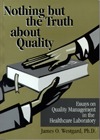ISO
ISO Says So: Recommendations for Validation of User QC
- What's a manufacturer to do?
- Do-Good guidelines won't
- But, ISO Says So
- What's a laboratory to do?
- References
September 2003
I recently purchased a copy of ISO/DIS 15198: Clinical laboratory medicine – In vitro diagnostic medical devices – Validation of manufacturer’s recommendations for user quality control [1]. It’s available from NCCLS for $55, but don’t waste your money - it doesn’t say anything! The document is only 4 pages long and one page is definitions and another page references. I’ll summarize the other useless information in the discussion here.
[Note: Don’t confuse 15198 with 15189, though the numbers are similar. ISO/DIS 15189 has to do with “particular requirements for quality and competence” in medical laboratories, which is aimed at service laboratories, not manufacturers. This one – 15198 – is specifically intended to help manufacturers help laboratories do the appropriate QC for their methods.]
What’s a manufacturer to do?
The document acknowledges that “the manufacturer of an IVD device is expected to provide specific, validated recommendations for quality control” and states that “this standard for manufacturers of IVD devices describes how to develop and validate recommendations for quality control to users.” To fulfill this obligation, here’s what a manufacturer should do (page 3 of said document):
- “Validation planning. The manufacturer of an IVD device shall develop a validation plan for quality control recommendations that require validation.”
- “Validation responsibility. The manufacturer shall assign the responsibilities for the validation taking into consideration that different disciplines may be necessary for different types of products or for different types of validation needs or phases (planning, protocols, execution, review, etc). Those responsible for it shall review the validation for comprehensiveness, statistical appropriateness and clinical appropriateness. A cross-functional team of experts may be formed to oversee the validation activities.”
- “Elements of the plan. Validation plans for quality control schemes shall consider the outputs from the Risk Analysis tools the Manufacturer may have employed during the design and development of the Device. Validation studies shall be designed to demonstrate the effectiveness of the QC procedures recommended by the manufacturer. Acceptance criteria linked to the performance claims shall be established prior to data collection. All statistical tests and sample size calculations shall be justified. These elements shall be documented in a validation protocol, which shall be approved prior to data collection.”
- “Performance evaluation studies. Results from internal and external evaluation studies shall be considered and, where appropriate, incorporated into the control scheme. Where a manufacturer enlists external sites to develop or validate recommendations for user quality control, such sites should, to the extent possible, reflect the user environments associated with the intended use of the device.”
- “Validation summary. The last stage is the preparation of the Validation Summary, which provides a synopsis of the validation objectives and data. The validation summary shall show that all of the acceptance criteria have been met. If the decision is made to make adjustments and or changes to the validation design, the changes shall be validated.”
- “Manufacturer’s records. The manufacturer will maintain records in accordance with ISO 9001, Quality management systems – Requirements and/or ISO 13485 Quality Systems, Medical Devices – Particular Requirements for the Application of ISO 9001.”
- Product information. The instructions for use (labeling) shall specify the validated quality control recommendations.
In short, the manufacturer is responsible for developing a plan, following that plan, preparing a report, maintaining records, and providing QC instructions to the user through proper labeling of the product. These guidelines are generic enough to apply to anything, but lack the details for developing useful and objective QC recommendations for laboratory methods.
 We invite you to read the rest of this article
We invite you to read the rest of this article
This complete article and many more essays can be found in the Nothing but the Truth about Quality manual, available in our online store. You can also download the Table of Contents and additional chapters here.
